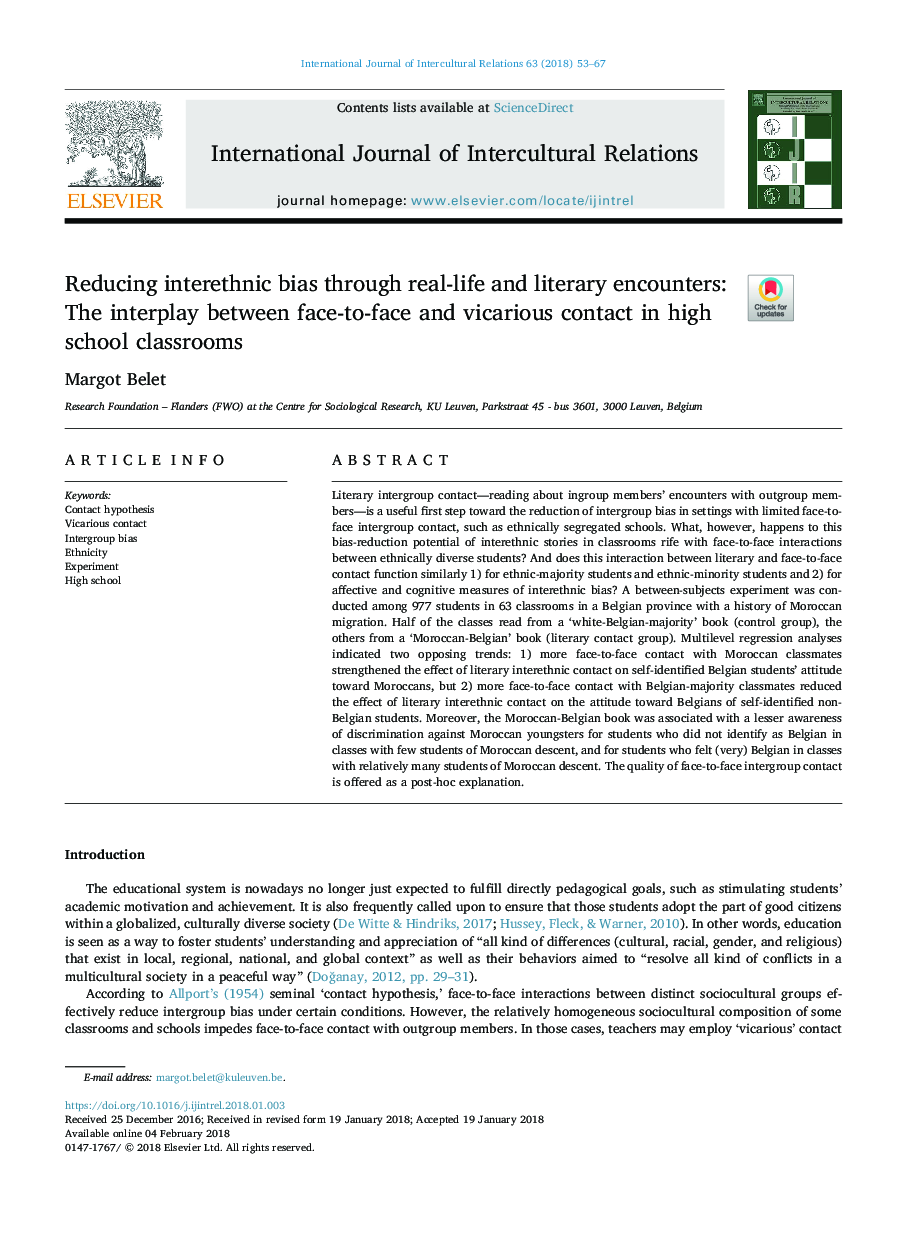| کد مقاله | کد نشریه | سال انتشار | مقاله انگلیسی | نسخه تمام متن |
|---|---|---|---|---|
| 7323636 | 1475727 | 2018 | 15 صفحه PDF | دانلود رایگان |
عنوان انگلیسی مقاله ISI
Reducing interethnic bias through real-life and literary encounters: The interplay between face-to-face and vicarious contact in high school classrooms
ترجمه فارسی عنوان
کاهش تعصب بین النهرین از طریق روابط واقعی و ادبی: درگیری بین مخاطب چهره به چهره و همسر در کلاس های دبیرستان
دانلود مقاله + سفارش ترجمه
دانلود مقاله ISI انگلیسی
رایگان برای ایرانیان
کلمات کلیدی
فرضیه تماس بگیرید، تماس جانانی، تعصب بین گروهی، قومیت، آزمایشی دبیرستان،
ترجمه چکیده
تماس مخاطب ادبی میان گروهی در مورد برخورد گروهی از اعضای گروه با اعضای خارج از گروه - اولین گام مفید برای کاهش تعصب گروهی در تنظیمات با مخاطبین میان گروهی چهره به چهره محدود، مانند مدارس جداگانه قومی است. با این حال، چه چیزی به این پتانسیل کاهش تعصب داستان های بین النهرین در کلاس های درس مربوط می شود که با تعاملات چهره به چهره بین دانشجویان مختلف قومی متفاوت است؟ و آیا این تعامل میان اثر ادبی و چهره به چهره به طور مشابه 1) برای دانش آموزان قومی اکثریت و دانشجویان قومی اقلیت و 2) برای اندازه گیری های عاطفی و شناختی از تعصب بین النهرین؟ آزمایشی بین افراد در میان 977 دانش آموز در 63 کلاس درس در یک استان بلژیکی با تاریخ مهاجرت مراکش انجام شد. نیمی از کلاسها از یک کتاب "اکثریت سفید سفید" (گروه کنترل)، دیگران از کتاب "مراکش-بلژیکی" (گروه تماس ادبی) خواندند. تجزیه و تحلیل رگرسیون چندسطحی نشان داد که دو گرایش متضاد: 1) ارتباط چهره به چهره با همکلاسی های مراکشی، تأثیر مخاطب بین المللی ادبی را بر نگرش دانشجویان خود نسبت به مراکش نسبت به بلژیکی تقویت کرد، اما 2) ارتباط چهره به چهره با بلژیکی همکلاسی های بزرگ، اثر ارتباطات ادبی بین النهرین را با نگرش نسبت به بلژیکی ها از دانش آموزان غیر بلژیکی شناسایی کرد. علاوه بر این، کتاب مراکش-بلژیکی با آگاهی کمتر درباره تبعیض علیه جوانان مراکش برای دانش آموزانی که در کلاس های با دانش آموزان مراکشی چند طبقه بلژیکی شناسایی نشده بودند، و دانشجویانی که بسیار بلژیکی را در کلاس های با دانش آموزان نسبتا زیادی احساس می کردند از تبار مراکش. کیفیت تماس میان گروهی چهره به چهره به عنوان یک توضیح بعد از وقایع ارائه شده است.
موضوعات مرتبط
علوم انسانی و اجتماعی
مدیریت، کسب و کار و حسابداری
کسب و کار و مدیریت بین المللی
چکیده انگلیسی
Literary intergroup contact-reading about ingroup members' encounters with outgroup members-is a useful first step toward the reduction of intergroup bias in settings with limited face-to-face intergroup contact, such as ethnically segregated schools. What, however, happens to this bias-reduction potential of interethnic stories in classrooms rife with face-to-face interactions between ethnically diverse students? And does this interaction between literary and face-to-face contact function similarly 1) for ethnic-majority students and ethnic-minority students and 2) for affective and cognitive measures of interethnic bias? A between-subjects experiment was conducted among 977 students in 63 classrooms in a Belgian province with a history of Moroccan migration. Half of the classes read from a 'white-Belgian-majority' book (control group), the others from a 'Moroccan-Belgian' book (literary contact group). Multilevel regression analyses indicated two opposing trends: 1) more face-to-face contact with Moroccan classmates strengthened the effect of literary interethnic contact on self-identified Belgian students' attitude toward Moroccans, but 2) more face-to-face contact with Belgian-majority classmates reduced the effect of literary interethnic contact on the attitude toward Belgians of self-identified non-Belgian students. Moreover, the Moroccan-Belgian book was associated with a lesser awareness of discrimination against Moroccan youngsters for students who did not identify as Belgian in classes with few students of Moroccan descent, and for students who felt (very) Belgian in classes with relatively many students of Moroccan descent. The quality of face-to-face intergroup contact is offered as a post-hoc explanation.
ناشر
Database: Elsevier - ScienceDirect (ساینس دایرکت)
Journal: International Journal of Intercultural Relations - Volume 63, March 2018, Pages 53-67
Journal: International Journal of Intercultural Relations - Volume 63, March 2018, Pages 53-67
نویسندگان
Margot Belet,
